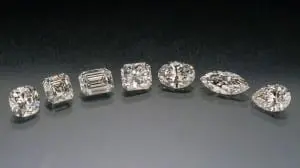Carat…how much does the diamond weigh?
When someone asks “how big is my diamond”, I have to tell them I don’t know. Carat is a weight and I can’t tell how much it weighs unless I put it on a scale. All I can do is take it’s measurements and tell them approximately how much it weighs.
Clarity…how big are the flaws and how many are there?
Flaws can look like black dots, white feathers, white clouds, chips, or cracks. If you can see a flaw with your naked eye, it is called an “I1”. The “I” stands for Imperfect. If you can see more than one, or if the one you see is really big, it is called an “I2”.
If you can’t see flaws with your naked eye, but you can see them easily with a 10 power magnifier, it is called “SI1” or “SI2”. The “SI” stands for Slightly Imperfect. These are my favorite kind of diamonds because they look flawless, but they’re a fraction of the cost of those that are flawless.
If it is really difficult for you to see flaws under 10 power magnification it could be “VS1” or “VS2” or “VVS1” or “VVS2”. These are Very Slightly imperfect or Very Very Slightly imperfect. The only diamonds better than these are Internally Flawless, “IF” and Flawless, “F”.
Color…duh.
The color grading scale starts at “D” and ranges all the way to “Z”. Why it doesn’t start at “A”? Years ago, before the Gemological Institute of America (GIA) created this standardized scale, jewelers just called their diamonds “A” quality, “B” quality, and “C” quality. The grading scale starts at “D” to avoid any confusion.
The color grade a diamond gets depends upon the amount of color in it, not the color tone. So a diamond with a brownish tone and one with a yellowish tone could get the same color grade if there is the same amount of brown in one as there is yellow in the other. Make sense? We generally recommend “G” or “H” or “I” color diamonds because they look colorless to most people, but they don’t cost nearly as much as colorless diamonds.
Cut…what is the shape and is it well proportioned?
Cut refers to two separate things. First, it describes the shape of a diamond. From left to right, the image below shows a Cushion cut, Asscher cut, Emerald cut, Radiant cut, Oval, Marquise shaped, and Pear shaped.
Secondly, cut describes the quality of the shape. For example, a poorly cut square stone could look like a bad rectangle. But it’s more complicated than that. A perfectly square diamond that is too deep or too shallow will hardly sparkle. The light will go right through it instead of reflecting back to you. People who buy the cheapest diamond based on what they see on a Certificate often get burned by this. You have to compare the diamonds, not just the certificates.
Certificates are a tricky thing. The Gemological Institute of America standardized the grading scale in 1955, but since then other laboratories have sprung up whose grading standards may or may not be as strict as GIAs. The industry has come to resemble some religious denominations; in-house fighting, differences of opinion, and debates about where to draw the lines. Pray for us :)
The answer is to remember that, if something looks too good to be true, it probably is. And, find a jeweler you can trust. He or she will know which labs are full of baloney. At Gold In Art Jewelers we recommend GIA, AGS, and EGL. They consistently have their act together.
